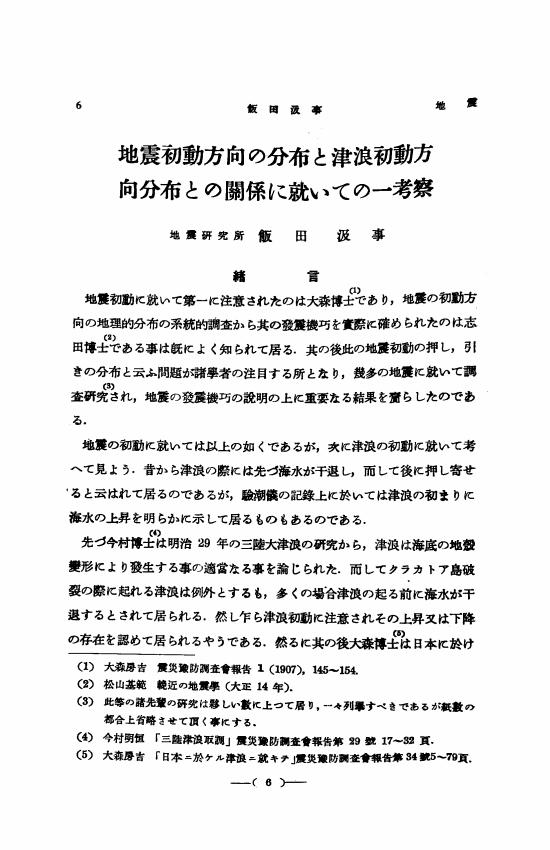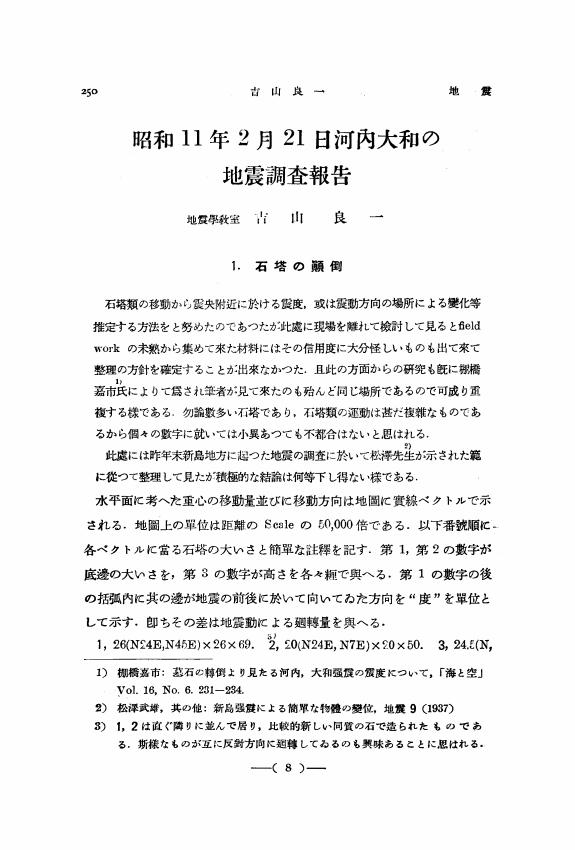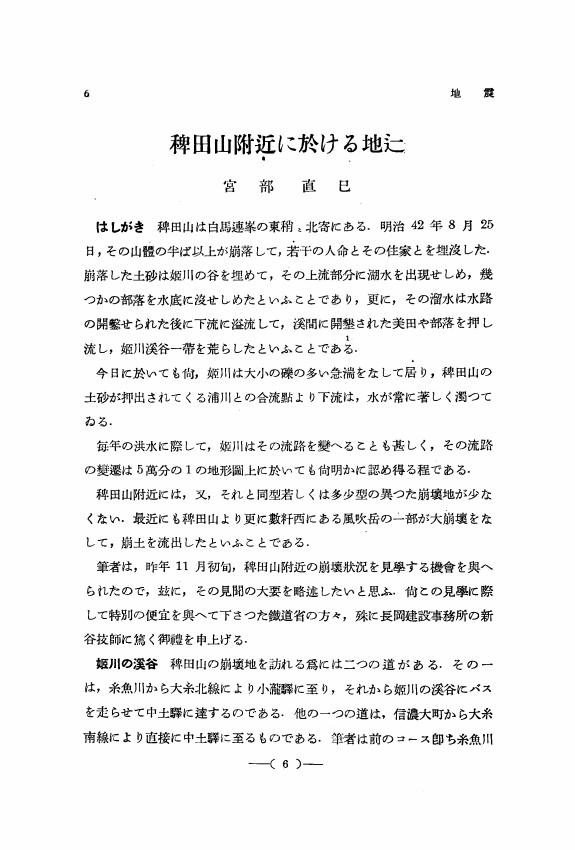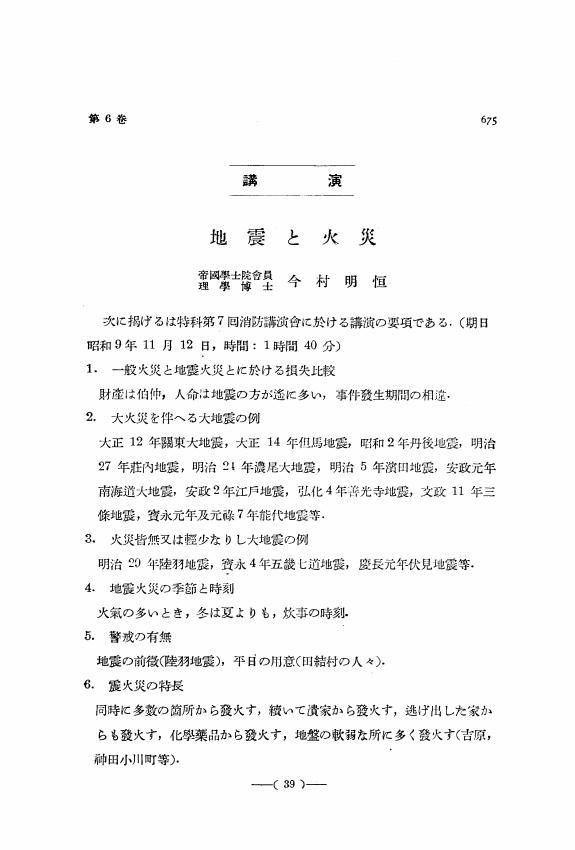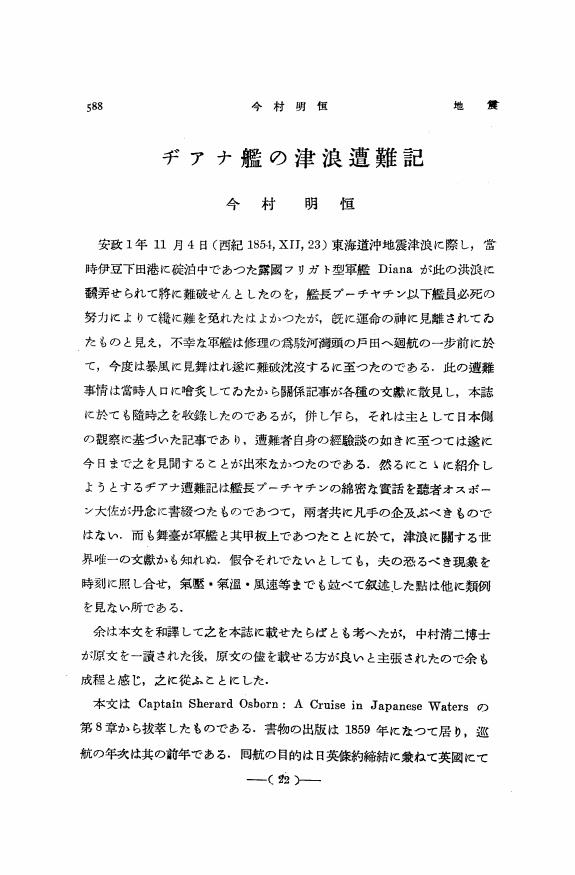2 0 0 0 OA 南米土人の地震豫知について
- 著者
- 武者 金吉
- 出版者
- 公益社団法人 日本地震学会
- 雑誌
- 地震 第1輯 (ISSN:00371114)
- 巻号頁・発行日
- vol.7, no.2, pp.63-71, 1935-02-15 (Released:2010-03-09)
- 参考文献数
- 25
2 0 0 0 OA 昭和14年5月1日男鹿地震の津浪
- 著者
- 岸上 冬彦 飯田 汲事
- 出版者
- 公益社団法人 日本地震学会
- 雑誌
- 地震 第1輯 (ISSN:00371114)
- 巻号頁・発行日
- vol.11, no.8, pp.365-371, 1939-08-25 (Released:2010-03-09)
- 参考文献数
- 5
- 著者
- 水野 真理子 佐藤 利典 篠原 雅尚 望月 公廣 山田 知朗 金澤 敏彦
- 出版者
- SEISMOLOGICAL SOCIETY OF JAPAN
- 雑誌
- 地震 第1輯 (ISSN:00371114)
- 巻号頁・発行日
- vol.62, no.1, pp.19-23, 2009
- 被引用文献数
- 2
2 0 0 0 OA 本邦正史に現はれる最初の大地震
- 著者
- 今村 明恒
- 出版者
- 公益社団法人 日本地震学会
- 雑誌
- 地震 第1輯 (ISSN:00371114)
- 巻号頁・発行日
- vol.16, no.5, pp.103-104, 1944-05-18 (Released:2010-11-17)
2 0 0 0 OA 廣村に於ける寳永安政兩度津浪の高さ
- 著者
- 今村 明恒
- 出版者
- 公益社団法人 日本地震学会
- 雑誌
- 地震 第1輯 (ISSN:00371114)
- 巻号頁・発行日
- vol.12, no.5, pp.220-222, 1940-05-25 (Released:2010-11-17)
2 0 0 0 OA 地震と芭蕉
- 著者
- 一窓庵
- 出版者
- 公益社団法人 日本地震学会
- 雑誌
- 地震 第1輯 (ISSN:00371114)
- 巻号頁・発行日
- vol.7, no.9, pp.496-497, 1935-09-15 (Released:2010-03-09)
1 0 0 0 OA 昭和10年7月11日静岡地震前後に起つた南伊豆蓮臺寺温泉水位の異状 (第2報)
- 著者
- 福富 孝治
- 出版者
- 公益社団法人 日本地震学会
- 雑誌
- 地震 第1輯 (ISSN:00371114)
- 巻号頁・発行日
- vol.12, no.5, pp.195-207, 1940-05-25 (Released:2010-11-17)
- 参考文献数
- 6
1 0 0 0 OA 小國地震, 日ノ御崎沖地震及び磐城沖地震の發光現象
- 著者
- 武者 金吉
- 出版者
- 公益社団法人 日本地震学会
- 雑誌
- 地震 第1輯 (ISSN:00371114)
- 巻号頁・発行日
- vol.11, no.7, pp.337-343, 1939-07-25 (Released:2010-03-09)
- 参考文献数
- 9
1 0 0 0 OA ロングビーチ震災による地震工學の收穫
- 著者
- 齊田 時太郎
- 出版者
- 公益社団法人 日本地震学会
- 雑誌
- 地震 第1輯 (ISSN:00371114)
- 巻号頁・発行日
- vol.6, no.6, pp.318-325_1, 1934-06-15 (Released:2010-03-09)
1 0 0 0 OA 地震初動方向の分布と津浪初動方向分布との關係に就いての一考察
- 著者
- 飯田 汲事
- 出版者
- 公益社団法人 日本地震学会
- 雑誌
- 地震 第1輯 (ISSN:00371114)
- 巻号頁・発行日
- vol.12, no.1, pp.6-14, 1940-01-25 (Released:2010-11-17)
- 参考文献数
- 19
1 0 0 0 OA 地震動の大きさと其の卓越振動周期
- 著者
- 飯田 汲事
- 出版者
- 公益社団法人 日本地震学会
- 雑誌
- 地震 第1輯 (ISSN:00371114)
- 巻号頁・発行日
- vol.13, no.3, pp.67-74, 1941-03-25 (Released:2010-11-17)
- 参考文献数
- 13
1 0 0 0 OA 昭和11年2月21日河内大和の地震調査報告
- 著者
- 吉山 良一
- 出版者
- 公益社団法人 日本地震学会
- 雑誌
- 地震 第1輯 (ISSN:00371114)
- 巻号頁・発行日
- vol.9, no.6, pp.250-260, 1937-06-15 (Released:2010-03-09)
- 参考文献数
- 4
1 0 0 0 OA 男鹿地震考
- 著者
- 今村 明恒
- 出版者
- 公益社団法人 日本地震学会
- 雑誌
- 地震 第1輯 (ISSN:00371114)
- 巻号頁・発行日
- vol.11, no.8, pp.372-384, 1939-08-25 (Released:2010-03-09)
1 0 0 0 震度のリアルタイム演算法
- 著者
- 功刀 卓 青井 真 中村 洋光 藤原 広行 森川 信之
- 出版者
- SEISMOLOGICAL SOCIETY OF JAPAN
- 雑誌
- 地震 第1輯 (ISSN:00371114)
- 巻号頁・発行日
- vol.60, no.4, pp.243-252, 2008
- 被引用文献数
- 20
A new calculation method is proposed for a real-time seismic intensity indicator (<i>I</i><sub>r</sub>), whose concept is similarly to the JMA seismic intensity (<i>I</i><sub>JMA</sub>)defined by Japan Meteorological Agency. With the increasing requirements of earthquake early warning (EEW) system, it is much more obvious that <i>I</i><sub>JMA</sub> has a real-time delay since the <i>I</i><sub>JMA</sub> needs a filtering operation in frequency domain. In order to improve the real-time calculation suitable for the EEW system, a new real-time seismic intensity indicator, <i>I</i><sub>r</sub> (real-time seismic intensity), is defined by using an approximating filter in time domain instead of the original filter in frequency domain. This indicator, <i>I</i><sub>r</sub>,can be calculated as a time series on real-time and its maximum value, <i>I</i><sub>a</sub> (approximate seismic intensity), corresponds to an approximate value of <i>I</i><sub>JMA</sub>. The relationships between <i>I</i><sub>JMA</sub> and <i>I</i><sub>a</sub> value are examined by means of using a large number of strong motion records. Results show that <i>I</i><sub>a</sub> value estimates <i>I</i><sub>JMA</sub> with reasonable accuracy in wide intensity ranges. For a small computing system like a strong-motion seismograph, it is easier to process <i>I</i><sub>r</sub> than processing <i>I</i><sub>JMA</sub>. Therefore, <i>I</i><sub>r</sub> is suitable for using in an EEW system based on the concept of JMA seismic intensity.
1 0 0 0 OA 稗田山附近に於ける地辷
- 著者
- 宮部 直巳
- 出版者
- 公益社団法人 日本地震学会
- 雑誌
- 地震 第1輯 (ISSN:00371114)
- 巻号頁・発行日
- vol.9, no.1, pp.6-14_1, 1937-01-15 (Released:2010-03-09)
1 0 0 0 宮古島近海における固有地震活動
- 著者
- 溜渕 功史 山田 安之 石垣 祐三 高木 康伸 中村 雅基 前田 憲二 岡田 正実
- 出版者
- SEISMOLOGICAL SOCIETY OF JAPAN
- 雑誌
- 地震 第1輯 (ISSN:00371114)
- 巻号頁・発行日
- vol.62, no.4, pp.193-207, 2010
We found eight <I>M</I> 5.1 characteristic earthquakes regularly occurring since 1966 on the plate boundary between the Eurasian plate and the Philippine Sea plate near Miyakojima Island, the Ryukyu Arc, Japan. The quake recurrence interval was 5.89 years in average, and the standard deviation was only 0.73 years. The accumulating stress presumably ruptured the same asperity enclosed by the creeping zone repeatedly. Also, we found three other groups of small repeating earthquakes of <I>M</I> 4, which occurred close to the hypocenters of the <I>M</I> 5 events. Those groups also occurred regularly and we can consider them to be 'characteristic' earthquake sequences. Now, we called those groups A, B, and C. It is not clear whether groups A and B had an intrinsic recurrence interval or if they influenced each other. However, two events of group C occurred within one week after the <I>M</I> 5 quakes, indicating that the <I>M</I> 5 events triggered the group C events whose asperity had suffcient strain energy. No earthquake exceeding <I>M</I> 7, which could change the recurrence intervals, has been observed on the subduction zone around the Ryukyu Islands. Therefore, there should be numerous characteristic earthquake sequences in other areas of the Ryukyu district. We expect that the next <I>M</I> 5 earthquake at 50 km depth on the plate boundary near Miyakojima Island will occur between September 2012 and July 2014 with 70% probability, using the small-sample theory with a log-normal distribution model. Moreover, the <I>M</I> 5 event may be accompanied by an <I>M</I> 4 quake that could rupture the asperity of group C within one week.
1 0 0 0 数論的地震活動モデル
- 著者
- 藤原 広行
- 出版者
- SEISMOLOGICAL SOCIETY OF JAPAN
- 雑誌
- 地震 第1輯 (ISSN:00371114)
- 巻号頁・発行日
- vol.66, no.4, pp.67-71, 2014
There is a similarity between the distribution of prime numbers and the pattern of earthquake occurrence. Earthquakes occur in a discrete manner in time and space. When viewed as a whole, however, we find some laws, such as Gutenberg-Richter law, that govern the entire earthquakes that seem to be individually independent. A similar phenomenon can be observed also in the world of number. The most basic example is the distribution of the prime numbers in integers. We consider a correspondence between earthquakes and prime numbers. We parameterize occurrence time of earthquakes as the prime numbers and magnitude of earthquakes as the interval of prime numbers. Then we obtain a relationship similar to Gutenberg-Richter law. We call the model obtained by this correspondence as "arithmetic seismic activity model". If we can parameterize earthquakes using prime numbers, knowledge that has been cultivated in the number theory can be used for understanding of earthquakes. The distribution of prime numbers is related to the distribution of zeros of Riemann zeta function. Researches are in progress to understand the zeros of the Riemann zeta function as an eigenvalue problem of quantum dynamical system. Earthquake may be modeled as a phenomenon corresponding to a change in the energy level of a quantum dynamical system associated with prime numbers.
1 0 0 0 OA 有珠山の噴火状況
- 著者
- 田中館 秀三 三松 正夫 今村 明恒
- 出版者
- 公益社団法人 日本地震学会
- 雑誌
- 地震 第1輯 (ISSN:00371114)
- 巻号頁・発行日
- vol.16, no.10, pp.280-287, 1944-10-18 (Released:2010-11-17)
本調査は, 国中館秀三君の依頼と指導とに依りて, 三松正夫君に依つて成されたものである。三松君は, 有珠山の東北麓, 壯轡村瀧之町の郵便局長を勤めて居られる。田中館君より編者への通信に據れば, 「同局長に依頼して, 山の異變に胴する時々の牀況を記録し, 或は之をスケッチして報告して貰ふごとにしたが, 既に數同の報告が同封の通り到來してゐる。同氏は, 南豊を能くするだけに, 其のスケッチには冩眞とは異なつた氣分が出てゐる。私留守中 (目下朝鮮へ出張) は, スケッチ等は直接先生 (今村) へ御送りするやう手筈するから, 然るべく雑誌地震へでも發表して下さらば幸甚, 云々」とある。成程, 記録は簡潔で, スケッチは摘要を旨とし, 遠景用でない普通の冩眞器に依つて撮影したものよりもわかり易い。有珠山活動の経過を迫跡するには眞に好個の資料と稻すべきである。乃ち其の好意に應ずることにし, 蛇足ではあるが, 前後及び中間に, 有珠活動の経過を挿み, 讃易いやうにした。
1 0 0 0 OA 地震と火災
- 著者
- 今村 明恒
- 出版者
- 公益社団法人 日本地震学会
- 雑誌
- 地震 第1輯 (ISSN:00371114)
- 巻号頁・発行日
- vol.6, no.12, pp.675-676, 1934-12-15 (Released:2010-03-09)
1 0 0 0 OA ヂアナ艦の津浪遭難記
- 著者
- 今村 明恒
- 出版者
- 公益社団法人 日本地震学会
- 雑誌
- 地震 第1輯 (ISSN:00371114)
- 巻号頁・発行日
- vol.11, no.12, pp.588-598, 1939-12-25 (Released:2010-03-09)








